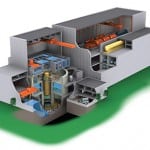GE Hitachi Nuclear Energy (GEH) today announced its next-generation reactor model, the Economic Simplified Boiling Water Reactor (ESBWR), has received a positive final safety evaluation report (FSER) and final design approval (FDA) from the U.S. Nuclear Regulatory Commission (NRC). The FDA constitutes a finding by the NRC staff that the ESBWR design is safe and all technical issues have been resolved. It clears the way for the ESBWR to be built in countries around the world that recognize the FDA of a reactor design as acceptance by the “country of origin.”
The NRC’s positive FSER clears the path for GEH’s ESBWR to receive the agency’s final design certification in the fall of 2011, providing regulatory finality of the ESBWR design in the United States.
Michigan utility DTE Energy has selected the ESBWR design for a potential reactor project next to its existing Fermi 2 plant south of Detroit. The NRC is currently reviewing DTE Energy’s license application for the Fermi 3 project, which serves as the “reference combined license application” for the ESBWR design.
The ESBWR is GEH’s newest reactor design that offers the world’s most advanced passive safety systems, simplified construction and operation, as well as the lowest core damage frequency on the market today, the company says.
“The ESBWR is one final step away from becoming a reality,” said Caroline Reda, president and CEO of GEH. “The FSER and FDA mark a crucial step forward for the ESBWR’s global commercial prospects. We appreciate the diligence of the NRC during the review process, which enables the ESBWR to remain on track to receive the NRC’s final design certification by this fall.”
One of those key commercial prospects is India, which as part of its massive nuclear energy expansion program has identified a site that would feature multiple GEH ESBWR reactors.
In related news, with Poland proposing to build two nuclear power plants, GEH has been expanding its network of local equipment suppliers and engineering firms to prepare for potential reactor projects in that country. In February 2011, GEH signed a memorandum of understanding with the Institute of Atomic Energy in Poland (POLATOM), a research institute that advises the Polish government on nuclear energy issues. In January 2011, in Gdansk, GEH signed preliminary agreements with Poland’s Stocznia Gdansk, a major shipyard, and RAFAKO S.A., Europe’s leading boiler equipment manufacturer, to pursue opportunities to build nuclear reactor components for GEH.
Also in February 2011, GEH and Lockheed Martin Corp. signed an agreement for Lockheed Martin to design and manufacture the main reactor control room systems for the ESBWR.
Source: GEH








